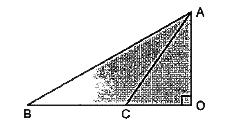A line PQ is drawn parallel to the side BC of ΔABC which cuts side AB at P and side AC at Q. If AB = 90 cm, CA = 60 cm and AQ = 4.2 cm, find the length of AP.
The correct Answer is:6.3cm
To solve the problem step by step, we will use the Basic Proportionality Theorem (also known as Thales' theorem) which states that if a line is drawn parallel to one side of a triangle, it divides the other two sides proportionally.
1. Identify the Given Information:
- Length of AB = 90 cm
- Length of AC = 60 cm
- Length of AQ = 4.2 cm
- Let the length of AP = x (unknown)
2. Set Up the Proportionality Equation:
According to the Basic Proportionality Theorem, we have:
APAQ=ABAC
Substituting the known values:
x4.2=9060
3. Simplify the Right Side:
The fraction 9060 can be simplified:
9060=32
So, we rewrite the equation:
x4.2=32
4. Cross Multiply to Solve for x:
Cross multiplying gives us:
2x=3×4.2
Calculate 3×4.2:
3×4.2=12.6
Therefore, we have:
2x=12.6
5. Divide by 2 to Find x:
Now, divide both sides by 2:
x=12.62=6.3
6. Conclusion:
The length of AP is:
AP=6.3 cm
Final Answer:
AP = 6.3 cm
- Length of AB = 90 cm
- Length of AC = 60 cm
- Length of AQ = 4.2 cm
- Let the length of AP = x (unknown)
According to the Basic Proportionality Theorem, we have:
APAQ=ABAC
Substituting the known values:
x4.2=9060
The fraction 9060 can be simplified:
9060=32
So, we rewrite the equation:
x4.2=32
Cross multiplying gives us:
2x=3×4.2
Calculate 3×4.2:
3×4.2=12.6
Therefore, we have:
2x=12.6
Now, divide both sides by 2:
x=12.62=6.3
The length of AP is:
AP=6.3 cm
AP = 6.3 cm
Topper's Solved these Questions
- SIMILARITY (WITH APPLICATIONS TO MAPS AND MODELS)BOOK - ICSECHAPTER - SIMILARITY (WITH APPLICATIONS TO MAPS AND MODELS)EXERCISE - EXERCISE 15(C)
24 Videos
- SIMILARITY (WITH APPLICATIONS TO MAPS AND MODELS)BOOK - ICSECHAPTER - SIMILARITY (WITH APPLICATIONS TO MAPS AND MODELS)EXERCISE - EXERCISE 15(D)
18 Videos
- SIMILARITY (WITH APPLICATIONS TO MAPS AND MODELS)BOOK - ICSECHAPTER - SIMILARITY (WITH APPLICATIONS TO MAPS AND MODELS)EXERCISE - EXERCISE 15(A)
48 Videos
- SIMILARITY BOOK - ICSECHAPTER - SIMILARITY EXERCISE - MULTIPLE CHOICE QUESTIONS (COMPETENCY BASED QUESTIONS)
10 Videos
- SOLVING (SIMPLE) PROBLEMS (BASED ON QUADRATIC EQUATIONS)BOOK - ICSECHAPTER - SOLVING (SIMPLE) PROBLEMS (BASED ON QUADRATIC EQUATIONS)EXERCISE - Exercise 6(e )
18 Videos
Similar Questions
A line segment DE is drawn parallel to base BC of A ABC which cuts AB at point D and AC at point E. If AB = 5 BD and EC = 3.2 cm, find the length of AE.
View SolutionA line PQ is drawn parallel to the base BC of ΔABC which meets sides AB and AC at points P and Q respectively. If AP=13PB, find the value of :
Area of ΔABCArea of ΔAPQ
View SolutionA line PQ is drawn parallel to the base BC of ΔABC which meets sides AB and AC at points P and Q respectively. If AP=13PB, find the value of :
Area of ΔAPQArea of trapeziumPBCQ
View SolutionΔABC is right-angled at C. If AC=5cmandBC=12cm find the length of AB.
View SolutionAP, AQ and BC are tangents to the circle. If AB = 5 cm, AC = 6 cm and BC = 4 cm, then the length of AP (in cm) is
View SolutionAP, AQ and BC are tangents to the circle. If AB = 5 cm, AC = 6 cm and BC = 4 cm, then the length of AP (in cm) is
View SolutionConstruct a ΔABC such
AB=5cm,BC=4.6cmandAC=4.3cm
View SolutionConstruct a ΔABC such
BC=6cm,CA=4cmandAB=3.5cm
View SolutionIn the given figure, a circle inscribed in a triangle ABC, touches the sides AB, BC and AC at points D, E and F respectively. If AB= 12 cm, BC= 8 cm and AC = 10 cm, find the lengths of AD, BE and CF.
View SolutionIn triangle ABC, given below, AB = 8 cm, BC = 6 cm and AC = 3 cm. Calculate the length of OC

View Solution
